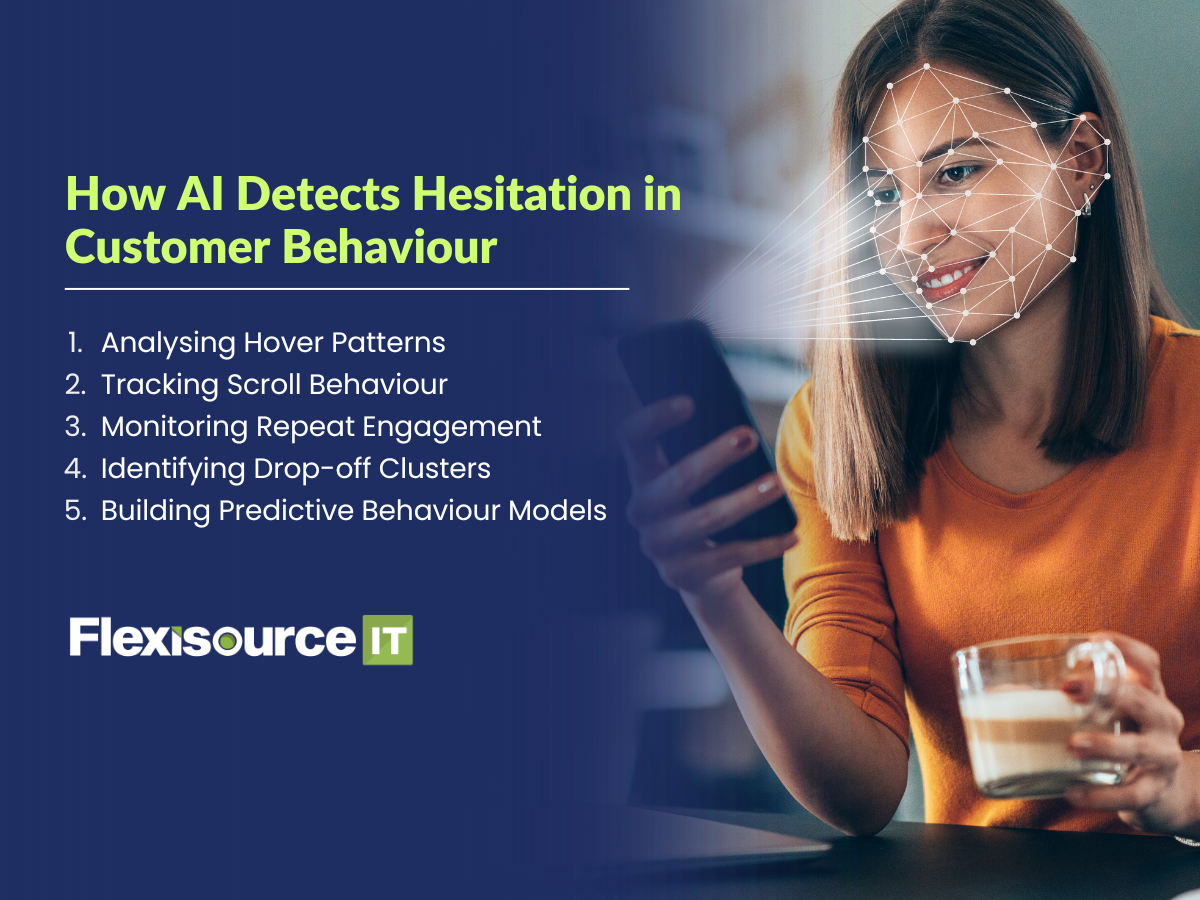Ever been this close to buying something online, only to pause because something just didn’t feel right? Maybe the fit wasn’t clear. Maybe the return policy looked vague. Or maybe, just maybe, you weren’t fully convinced that the product or brand would meet your expectations.
That tiny pause? It happens to millions of shoppers every day. And it is in those split seconds, known as micro hesitations, where conversion truly happens or dies. What if we told you that AI can now read those moments of uncertainty and respond in real time?
How AI Detects Customer Hesitation & Turns It Into Sales
Many shoppers reach the final step with intent to buy but suddenly pull back. This customer hesitation often stems from uncertainty, not a lack of interest. It’s a critical moment where attention can either convert into a sale or disappear altogether.
Psychologists call this ambiguity aversion—our brain’s instinct to avoid unclear outcomes. Whether it’s confusion about sizing, delivery time, or compatibility, doubt can stop a purchase in its tracks. Even minor gaps in information can feel like risks the customer doesn’t want to take.
This is where AI steps in as a game-changer. It helps streamline business operations through real-time responses to patterns like hesitation on specific sections or repeated comparisons. That timely reassurance often turns hesitation into confidence and drives the final decision to purchase.
Note: AI doesn’t just track behaviour—it reads uncertainty and gives businesses the tools to resolve it before the sale is lost.
How AI Detects Hesitation in Customer Behaviour
Understanding when a customer is hesitant is key to turning interest into action. With AI detection for marketing, businesses can now identify subtle signs of doubt before a customer decides to leave.

1. Analysing Hover Patterns
AI notices when users linger over certain elements, like the shipping policy, without taking action. When this happens across thousands of visits, it becomes a pattern of hesitation. These moments help the system understand where customers begin to second-guess.
2. Tracking Scroll Behaviour
If a customer scrolls back up to recheck product details or compare features, AI takes it as a sign of indecision. This type of backtracking suggests the person needs more clarity or confidence. By tracking these actions, AI helps identify content gaps that may be slowing conversions.
3. Monitoring Repeat Engagement
When a user clicks on the return policy more than once in a session, the AI flags it as a potential concern. This repetition signals uncertainty or fear about the purchase. Recognising these patterns helps marketers address objections before a customer bounces.
4. Identifying Drop-off Clusters
AI can detect where visitors tend to exit a site, such as after reading FAQs or checking delivery options. These common drop-off points reveal exactly where trust is lost. With this knowledge, marketers can adjust content and layout to keep users engaged.
5. Building Predictive Behaviour Models
As it collects data, AI learns to predict when a customer is close to abandoning a purchase. It analyses combinations of behaviours like hovering, scrolling, and pausing. These predictions let teams take action in real time, offering timely support or content that keeps users on track.
How AI Helps You Win Over Hesitant Customers
Most customers don’t bounce because they’re uninterested. They leave because they’re unsure. With the right AI tools, you can guide them through that hesitation and make them feel seen, supported, and ready to say yes.

1. Find the Drop-Off Points
Don’t just guess where customers are slipping away—track it. Use heatmaps and session recordings to uncover hesitation zones, like pages with high exit rates or sections where people scroll but don’t click. These signals reveal where users need more clarity or reassurance to move forward.
2. Create Content That Builds Trust
If people can’t find clear answers, they might not go through with the purchase. Add things like reviews, return info, size guides, or behind-the-scenes videos to build trust. AI in content marketing can also help tailor this content to what customers need most. The goal? Make them feel confident and supported.
3. Set Up AI to React in Real-Time
AI works best when it steps in at the right moment—not too early, not too late. Trigger personalised messages, chat support, or product nudges only when someone shows signs of uncertainty. Think of it as giving them a gentle, helpful nudge instead of a pushy sales pitch.
4. Keep Testing
What works today might flop tomorrow—so don’t set and forget. Run A/B tests on your copy, calls-to-action, reassurance messages, and even the tone of your chatbot. Every data point is a clue to better supporting your customers’ decision-making journey.
5. Monitor Metrics That Matter
Go beyond basic conversion rates—zoom in on behaviours like returning to the same product, engaging with reviews, or lingering on FAQs. These are signs that people are almost there. When you see patterns shift after implementing AI, you’ll know you’re easing doubts effectively.
Think Beyond Your Website
AI doesn’t stop at your product pages. To truly reduce hesitation and boost conversions, apply it across your wider digital presence—wherever your customers are making decisions.
Search
Search is often where doubt begins, so it’s crucial to address it early.
- Use AI to understand what questions your audience is asking before they click.
- Tailor ad copy to directly answer objections or clarify value.
- Optimise landing pages to deliver clear, trustworthy answers fast.
- Highlight independent reviews or guarantees to add credibility.
Social Media
Social platforms shape how people feel about your brand before they even visit your site.
- Share real customer stories or testimonials that tackle common concerns.
- Post behind-the-scenes content to show authenticity and transparency.
- Use polls or Q&As to surface doubts and build content that addresses them.
- Use social media analytics to spot patterns and understand customer concerns early.
Email gives you a chance to follow up with context and care.
- Use behavioural data to send helpful nudges, not just reminders.
- Share FAQs, tutorials, or return policies to build post-click confidence.
- Segment your emails based on user intent or hesitation points.
- Let AI personalise content that reassures and supports the buying decision.
Final Thoughts
Customer hesitation is rarely about a lack of interest. More often, it stems from uncertainty or a need for clearer information before making a decision. Thanks to AI detection, businesses can now recognise these brief moments of doubt and act quickly to help customers proceed with greater confidence.
By detecting behaviours such as repeated page visits or extended pauses, AI reveals where your messaging may fall short. Addressing these uncertainties promptly allows you to build trust and encourage more shoppers to complete their purchase. Embracing this technology is key to turning hesitation into conversion.
If customer hesitation is costing you sales, it’s time to take action. Contact Flexisource IT and let our expert developers build AI detection solutions tailored for your business.







